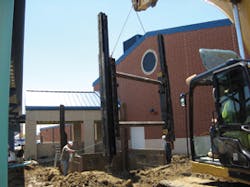GM Mechanical Inc., based in Covington, OH, recently installed a 20,000-gallon rainwater storage tank at Miami East High School in Casstown, OH. The 10-foot diameter, 38-foot-long tank was installed about 15 feet deep. No big deal, right? Well, there was one tiny, little, impediment: The contractor installed the tank less than 5 feet from three existing structures, including a wall of the high school.
“Normally we subcontract for site work like that, but there were problems with the original design for shoring,” says Jack Liddy, GM Mechanical’s project superintendent. “So we ended up installing the tank ourselves.”
Liddy contacted Efficiency Production Inc.-a leading manufacturer of trench shielding and shoring equipment-for assistance designing a shoring system that would fit into the very tight excavation area and still meet safety regulations.
After a careful examination of the blueprints, Efficiency sent Liddy proposal CAD drawings that detailed how a slide-rail shoring system could and would work in the tank’s tight spot.
Efficiency’s Universal Slide Rail is a component shoring system composed of steel panels (similar to trench shield sidewalls) and vertical steel posts. The highly versatile system can be used in a variety of configurations. Efficiency’s Universal Slide Rail can be configured into small four-sided pits; an obstruction-free ClearSpan configuration; or in a Multi-Bay configuration to install large tanks and structures, or lengths of pipe over 40 feet.
Slide Rail is installed by sliding the panels into integrated rails on the posts, and then pushing the panels and posts incrementally down to grade as the pit is dug; a process commonly referred to as a dig-and-push shoring system.
Slide rail is considered “active shoring,” which means that personnel and equipment can be safely in the hole throughout the entire installation and removal process. The system is installed simultaneously as the trench or pit is excavated, while over-cutting outside the system is entirely unnecessary. The individual component pieces can be handled with a standard size excavator which means that excavation contractors can usually install the shoring system themselves.
Because this was the first time GM Mechanical had used Efficiency’s slide-rail system, Efficiency sent out shoring specialist Rod Austen to assist with the initial installation. “It was a very difficult spot to be digging,” said Austen. “What complicated things even further, was that the excavator had access to the site from only one side,” Austen explains.
“(Austen) was very good at giving exact directions without giving too much information,” says Liddy. “And even after he left, he stayed available for any questions we had.”
GM Mechanical used a Cat 330 excavator with help from a front loader to dig the hole and install the Slide Rail System. They utilized a two bay, four-sided multi-bay configuration which provides a larger unobstructed area for installing the tank.
“The original design for the slide rail was two equal size bays,” explains Liddy. “But because we only had access on one end, Rod changed up the equipment so we had a shorter end bay. This allowed our excavator to reach to the far side of the pit.”
GM Mechanical excavated and installed the slide rail shoring in two days. It took two days to install and hook up the tank, then less than two days to remove the slide rail components.
Overall, Liddy is impressed with the system. “This is not just for specialty work. I’d use it again anytime we need to put in a tank. It really helps reduce the amount of excavating necessary, and the amount of backfill that goes with it,” Liddy concludes.



